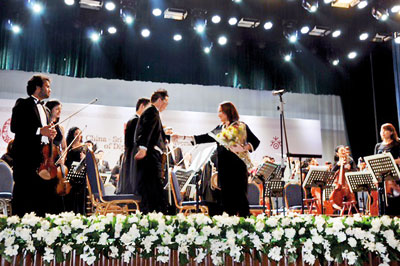From the familiar to the unfamiliar: Rapturous melodies at the BMICH

Chinese soprano Chen Junhua in full flow, and below, the winds
The Symphony Orchestra of Sri Lanka (SOSL) collaborated with the China National Symphony Orchestra (CNSO) to present an evening of classical music at the BMICH on February 6. This was to celebrate 60 years of diplomatic relations between the two nations. The SOSL musicians comprised about one-fourth of the combined orchestra, which collectively demonstrated a high degree of professionalism. It was a treat to see such a large orchestra performing on Sri Lankan soil. This landmark event was attended by several dignitaries, including the President and Prime Minister.
There were two curtain-raisers: the Chinese and Sri Lankan national anthems in that order – the former imbued with a percussive military fervour, the latter with a bucolic charm that tugged at the heart strings. They were conducted by Xincao LI and Dushyanthi Perera, respectively. This was a powerful, well-knit orchestra and the pulsating sounds it produced set the stage for Ravibandhu Vidyapathy and his ensemble of eight drummers to premiere the Lamentation of Kuveni – a groundbreaking piece composed for drums and orchestra by Ravibhandu Vidyapathy (based on a traditional melody) and arranged by Jithendra Vidyapathy and Ravibandhu Vidyapathy.
There were four distinct movements differentiated by time signature and rhythm – contemplation, betrayal, lamentation and curse – collectively portraying the betrayal of a tribal princess (Kuveni) by a migrant prince (Vijaya). The absorbing narrative began with a single, high-pitched note (sostuneto) produced by what sounded like an oboe. Then came the orchestra followed by an overlay of drums melding neatly with the ensemble to introduce the central motif, which assumed various guises as the piece progressed. The periodic solos by Ravibandhu Vidyapathy were exemplary.
The composition, overall, was characterized by rich, percussive sounds woven around the main theme – a melodious current breathing life and substance into the orchestral score. The final movement (light, brisk, rhythmic) was divine but sounded more like scherzo than a curse. Dushyanthi Perera was successful in bringing out the essence of the music and demonstrated profound sensibility in the way she handled mood and tempi.
The rest of the programme was directed by Xincao LI, a world-class conductor. His trademark was the sweeping movement of his left hand to extract something more, something special, from his ensemble. To empower the musicians in this manner requires great skill and charisma, both of which he possessed in abundance. Rarely does a conductor of such distinction grace our shores.

Under his baton, we first heard a powerful contemporary piece with a profoundly classical touch: Fantasies Symphoniques, written by the eminent composer and Director of the CNSO, Guan Xia. The composition (for soprano and orchestra) is based on a well-known, epic tale, Farewell my Concubine, set in 300 B.C. (Incidentally, there is an opera and a movie by the same name.) The audience was introduced to some widely-used, traditional instruments such as the Chinese bamboo flute (played by Hou Changqing); the guzheng – a Chinese zither (played by Ji Wei); and the erhu – a two-stringed, bowed instrument (played by Shuang Wang). All three musicians enjoy celebrity status in their homeland and mesmerized the audience with their musicality and technical artistry.
The Fantasies was imbued with a strong romantic flavour and relied heavily on sonorous, brass-driven percussion to transport the audience into the theatre of war. The piece was punctuated by tumultuous crescendos interwoven with poignant cadenzas. The middle-section had some quiet, contemplative moments, but little by way of the subtleties and nuances associated with major western, classical composers. There was, however, a hint of Shostakovich and Mahler in respect of ambivalent tonality and grotesque imagery. The plot of Farewell my Concubine, after all, is rooted in the destructive and tragic elements of war.
The plaintive sounds of the bamboo flute, the vibrato effects of the zither, and the wailing sounds of the erhu combined to produce a mélange of nostalgic moods and unusual colour tones. Add to these the reverberating boom of the Chinese gong and the shrill, piercing, amplified voice of the acclaimed singer, Chen Junhua (who, at one point, unleashed a stream of ear-splitting yowls to complement her colourful attire and imposing headgear), and voila! We have a litany of sounds unfamiliar to the Sri Lankan ear. This is what Chinese classical-contemporary music is all about, and for the audience, it was a mind-bending experience. The ensemble was fully charged and performed the beloved Fantasieswith verve and panache.

A bouquet for Dushyanthi Perera
The concert ended with Dvorak’s celebrated New World Symphony (composed in 1893).It was ideally suited for Xincao LI’s ebullient style of directing with that sweeping left hand constantly energizing the orchestra and goading it to raise the bar. And raise the bar, it did. We could sense those rapturous “oceanic” currents rippling through the four movements – adagio, largo, scherzo and allegro con fuoco – and building up to a dramatic finale. The judicious use of triangle, trumpet, tuba, cymbals and timpani gave the symphony a ravishing, full-bodied texture. The most endearing aspect of this intricate composition is the tuneful largo which, perhaps, was inspired by native-American music. The beauty of this deeply evocative movement was captured with remarkable grace and clarity by the strings, winds and brass. The climactic finale was rendered with fiendish energy and a luminous outpouring of passion superbly modulated by the conductor.
In sum, this was the kind of concert which epitomized the lofty phenomenon known as cohesive synergy – a stellar performance, in other words, which surpassed all expectations. There were some lambent moments that transported the audience to a higher sensory plane. The only fly in the ointment was the “cloudy” acoustics. The BMICH, after all, was never meant to be a concert hall.


